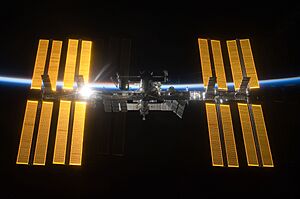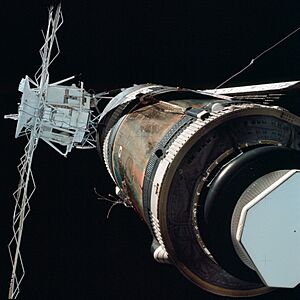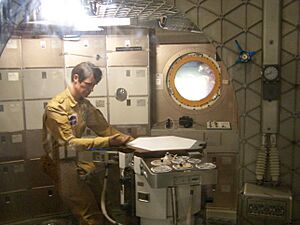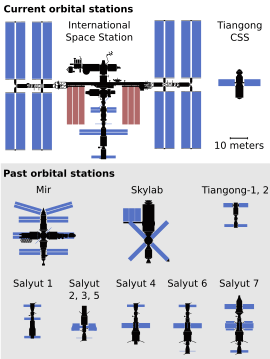List of space stations facts for kids


A space station is a large spacecraft that orbits a planet, like Earth. It is a special place where astronauts can live and work for weeks, months, or even a year at a time. Think of it as a science laboratory and a home in the sky.
Astronauts on a space station conduct important experiments that can't be done on Earth. Because there is very little gravity, they can study how things like fire, plants, and even their own bodies behave differently in space. These stations are built in pieces on Earth and assembled in orbit by astronauts.
Contents
Homes in the Sky: A History of Space Stations
The first space stations were launched over 50 years ago. Many of these early stations have completed their missions. They have since fallen back into Earth's atmosphere, where they burned up safely.
The First Space Pioneers: Salyut and Almaz
The very first space stations were part of the Salyut program from the Soviet Union in the 1970s. These were designed for scientific research. At the same time, the Soviet Union also had a secret military program called Almaz, which used space stations to test new technology.
America's First Workshop: Skylab
Skylab was the first space station launched by the United States. It was cleverly made from a part of the giant Saturn V rocket that was left over from the Apollo moon missions. Three crews of astronauts lived and worked on Skylab in 1973 and 1974, setting new records for time spent in space.
A Long-Lasting Legacy: Mir
The Mir space station was a major achievement. Launched by the Soviet Union in 1986, it was the first station built in sections, or modules, that were added over time. Mir orbited Earth for 15 years, much longer than planned. It hosted many astronauts and cosmonauts from different countries, teaching us how to live in space for long periods.
China's Stepping Stones: Tiangong-1 and Tiangong-2
Before building its current large space station, China launched two smaller test stations. Tiangong-1 ("Heavenly Palace 1") and Tiangong-2 were important practice labs. They helped Chinese astronauts learn key skills like docking spacecraft and living in orbit.
| Station Name | Country/Agency | Launched | Cool Fact |
|---|---|---|---|
| Salyut 1 | 1971 | The very first space station in history! | |
| Skylab | 1973 | America's first space station. It was made from a leftover part of a Saturn V moon rocket. | |
| Salyut 7 | 1982 | Famous for a daring rescue mission in 1985 when it lost all power and froze in orbit. | |
| Mir | 1986 | Orbited Earth for 15 years and was the first station built in pieces (modular). | |
| Tiangong-1 | 2011 | China's first "Heavenly Palace," a test lab for learning how to dock spacecraft. |
What's in Orbit Right Now?
Today, there are two fully operational space stations orbiting our planet, serving as homes and workplaces for international crews of astronauts.
| Name | Partners | Crew | Launched | Days in Orbit (and counting!) |
Living Space |
|---|---|---|---|---|---|
| International Space Station | 7 | 20 November 1998 | 9889 | 388 m3 (13,700 cu ft) | |
| Tiangong space station | 3–6 | 29 April 2021 | 1693 | 122 m3 (4,310 cu ft) |
The Next Generation of Space Stations
Space agencies and private companies are busy designing the next homes in orbit. Some will be for science and exploration, while others could be for space tourists!
Stations in Low-Earth Orbit
These stations will orbit close to Earth, similar to the ISS.
- Axiom Station: A private station that will first attach to the ISS. Later, it will separate and become its own independent outpost for research and tourism.
- Orbital Reef: Planned as a "business park in space" by companies like Blue Origin and Sierra Space. It will offer services for research, manufacturing, and even movies.
- Starlab: A commercial station that will have a large inflatable habitat. It will focus on science and research for customers around the world.
Beyond Earth's Orbit
- Lunar Gateway: This is a very special project to build a small space station that will orbit the Moon! It will not be lived in all the time. Instead, it will be a stopping point for astronauts traveling to the lunar surface as part of the Artemis program.
Space Stations That Never Flew

Not every planned space station makes it to the launch pad. Some projects were cancelled because they cost too much, or because new plans were made.
- Manned Orbiting Laboratory: A secret military space station planned by the U.S. Air Force in the 1960s. The project was cancelled before any astronauts could visit.
- Skylab B: A complete backup for the Skylab station was built just in case something went wrong with the first one. It was never needed and is now on display in a museum.
- Space Station Freedom: This was a big NASA project in the 1980s and 90s. The plans were later changed, and it became the foundation for the American parts of the International Space Station.
- Mir-2: Russia planned to build a replacement for the Mir station. Like Freedom, its modules were eventually used to help build the International Space Station instead.
Timeline

- China
- Soviet Union/Russia
- USA
- India
- multiple nations
See also
- Spacelab
- List of crewed spacecraft
- Commercial Space Stations
- Space stations and habitats in fiction


